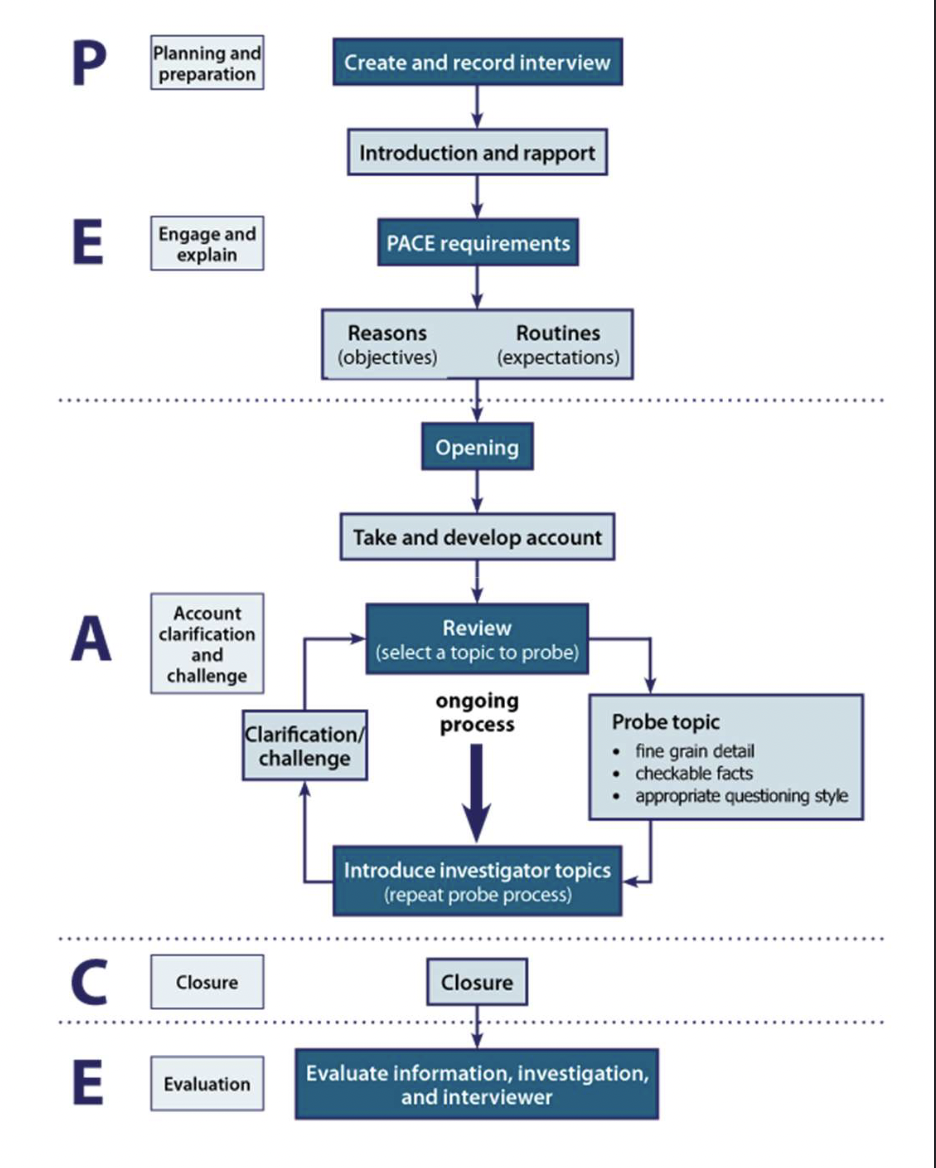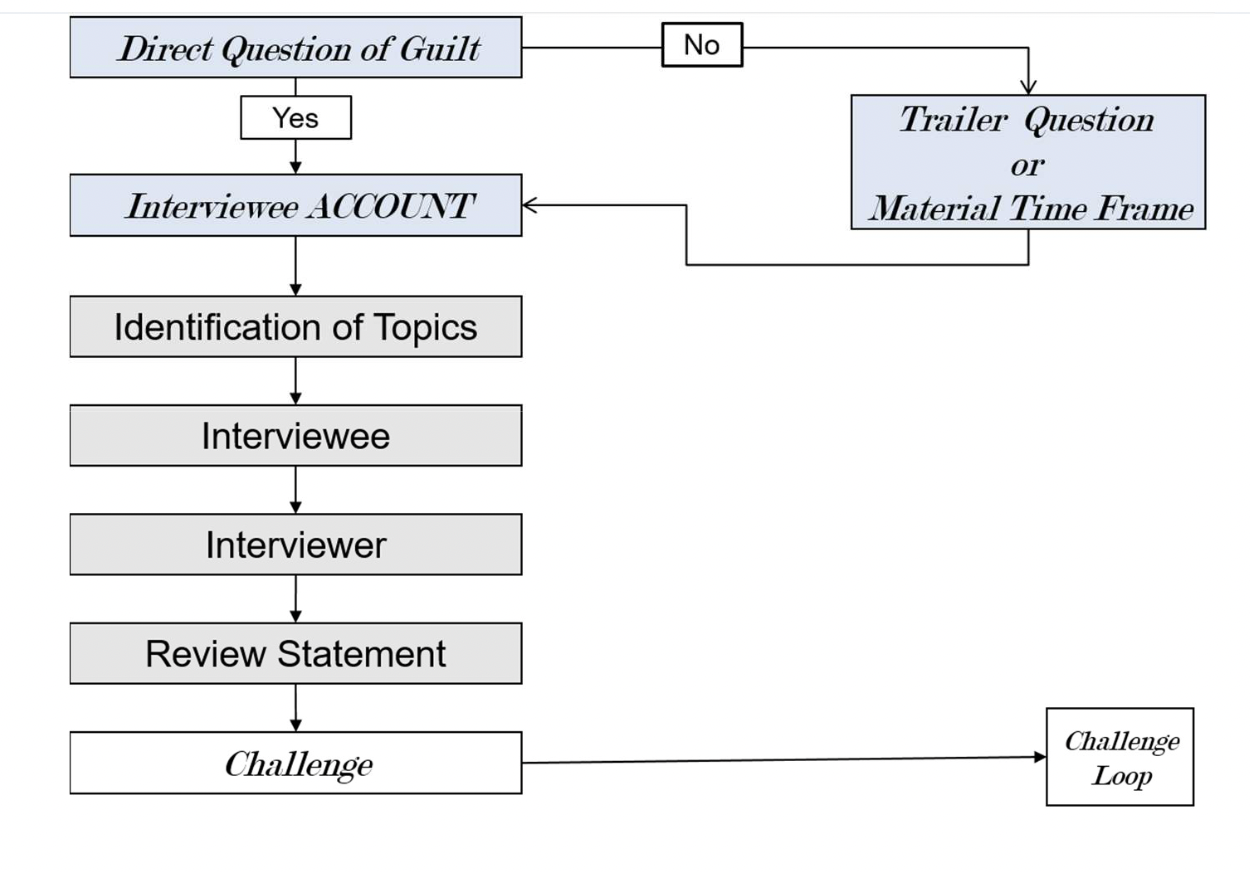Note
0.0(0)
Explore Top Notes Note
Note Studied by 5 people
Studied by 5 people Note
Note Studied by 23 people
Studied by 23 people Note
Note Studied by 16 people
Studied by 16 people Note
Note Studied by 16443 people
Studied by 16443 people Note
Note Studied by 43 people
Studied by 43 people Note
Note Studied by 14 people
Studied by 14 people
Forces and Elasticity
5.0(1)
Gaffney S1 Finals
5.0(1)
Bacteria
5.0(1)
AP English Language and Composition Ultimate Guide
5.0(6)
Passé Composé
4.0(1)
Jekyll and Hyde-Background and Context-Victorian Gentlemen
4.0(291)
PSYC 2400 Unit 3
PSYC 2400 Unit 3: Interviewing and Interrogations
Investigative Interviewing
- PEACE Model
- What is it?
- Why use it?
Police Investigations
- Interviewing witnesses, victims, and suspects is one of the most vital components of an investigation
- Often no physical evidence
- Must prove intent
- Interviewing allows investigators to:
- Fill in missing details from the investigation
- Collect additional evidence - by pursuing leads by what victims/witnesses have to say
- Obtain confessions
Interrogation vs. Interview
- Important distinction
- Obtain a confessionInterrogations
- Location of evidenceInterview
- Co-conspirators
- Exact details of the crime
- Interrogation vs. Interview
- Important distinction
- Interrogations ------> Obtain a confession
- Interview --------> Location of evidence
Co-conspirators
Exact details of the crime
Gathering information
Interrogations
- Brief history
- Reid Model
- What is it?
- What are the issues?
History of interrogations
- Early-1900s: third degree
- Whipping
- Rubber hoses
- Phone books
- 1970-80: torture tactics used in Chicago
- 1980: stun gun used by NYPD
- 2013: R. v. Singh
- Struck him on the head six times
- Kneed him in the ribs
- Grabbed his neck
- Squeezed his ribs
- Slammed his head against the wall
- Prolonged beating
- Acute fracture to the ribs
History of interrogations
- Today in North America – subtle psychological tactics and trickery
- Lie about physical evidence
- Moral justification
- Use of hypotheticals
- Imply threats about family members
Interrogations
- Brief history
- Reid Model
- What is it?
- What are the issues?
Reid Model of Interrogation
- The most widely used approach in North America
- It involves 3 stages:
- Gather evidence
- Non-accusatorial interview to assess guilt (detecting deception)
- 9-step accusatorial interrogation to obtain a confession
- No research to support its use
Step 1:
- Direct positive confrontation
- Police state certainty in suspect’s guilt
- Use fabricated or real evidence
- Pause, observe, repeat confrontation
- Passive reaction = deception
- State purpose of the interview is to figure out “why”
- Police state certainty in suspect’s guilt
Step 2
- Theme development
Emotional | Non-Emotional | |
|---|---|---|
Feels | Distress/ Remorse | Nothing Particularly |
Interrogator Approach | Sympathetic | Factual Analysis |
Appeal to… | conscience | Reasoning/Common Sense |
- Offer excuses/explanations for the offence
- Allow for justification and rationalization
- Possible themes for emotional suspects:
- Normalization of crime
- Minimize seriousness
- Suggest morally acceptable reasons
- Condemn others (e.g., victim)
- Praise & flattery
- Possible themes for non-emotional suspects:
- Catch them in a lie
- Get suspect associated with the crime scene
- Non-criminal intent behind the act
- No point in denying involvement
- Play one co-offender off the other
Step 3
- Do not allow denials
- Interrupt any attempted denials
- Repeated denials = less likely to confess
- Innocent suspect:
- Spontaneous
- Forceful
- Eye-contact
- Guilty suspect:
- Hesitant
- Defensive
- Interrupt any attempted denials
Step 4
- Allow objection & return to the theme
- Emotional, factual, moral
- Innocent suspect:
- Continues with original denials
- Guilty Suspect
- Moves from denials to objections
Step 5
- Retain the suspect’s attention
- Deal with withdrawal by the suspect
- Re-engage suspect
- Move closer
- Lean forward
- Make eye contact
- Increase psychological pressure
- Reduce physical distance
Step 6
- Handling passiveness
- Suspect is about to give in
- Slumped shoulders
- Crying and/or blank stare
- Focus on main theme and urge suspect to come clean
- Use sympathy and understanding
- Suspect is about to give in
Step 7
- Alternative question
- Present two explanations for crime
- One reprehensible
- One face-saving
- e.g., “Did you plan to kill her OR did it just happen?”
- Both produce a confession!
- The most important component of Reid
- This problem for many suspects
- Timing is critical
- Present two explanations for crime
Steps 8 & 9:
- Relate offence details
- Create written confession
- Get suspect to verbalize the offence
- Obtain full details of the crime
- Verbal confession to written confession
Reid in the real world
- King and Snook (2009)
- Canadian police interviews
- Model not adhered to completely
- Individual techniques used frequently by officers
- Evidence of guilt (80%)
- Flattery (60%)
- Minimize seriousness of crime (40%)
Identifying problems with the Reid Model of Interrogation
- Based on the myth that criminals will not voluntarily confess to committing a crime
- Make anxiety associated with not confessing greater than the anxiety related to confessing
- Reduce external and internal concerns through minimization and rationalization
1. Detecting deception
- Behavioural Analysis Interview (BAI)
- The purpose is to decide if guilty
- If yes, confession or bust
- Reid's technique based on deception detection
- People can’t do it! (Kassing & Fong, 1999)
- Training only increases confidence
- Innocent person may undergo coercive interrogation
2. Investigator bias
- Assumption of guilt by interrogator (Kassin & Fong, 1999)
- Ask more guilt-presumptive questions
- More coercive
- More persistent
- More pressure
- The suspect gets defensive – and looks guilty
3. Coercive tactics
- Minimization: “soft sell” techniques
- False sense of security
- Moral justification
- May imply leniency
- Maximization: scare tactics
- Intimidate suspect
- False claims about evidence
- Exaggerate seriousness of offence
4. Suspect vulnerabilities
- Current mental state
- Mentally weak (IQ < 80)
- Drugged/intoxicated
- Sleep deprivation
- Compliance & suggestibility
- State of anxiety
- Understanding of legal rights
5. Lasting effects
- Inadmissible confessions that are TRUE
- Coerced confessions result in resentment
- Coercion resulting in PTSD
- Undermining public confidence
- The ‘boomerang effect’
The PEACE Model of Investigative Interviewing
“Society cannot afford investigative interviewing to be poor. This affects people’s perceptions of the criminal justice system. The guilty get away, the innocent are convicted, justice for children and vulnerable adults is inadequate. Poor interviewing is of no value to anyone; it is a waste of time, resources and money. No one wins.”
Milne and Bull (1999, p. 191)
PEACE
- Introduced in the UK in 1992
- An extension of PACE (Police and Criminal Evidence act of 1984)
- Focus on Ethical interviewing (Roberts, 2012)
PEACE Model of Investigative Interviewing
- Preparation and Planning
- Engage and Explain
- Account
- Closure
- Evaluation
Preparation and Planning
- Interviewee characteristics
- Age, Mental status
- Contribution to investigation - why are they being interviewed
- Questions you want to ask
- Aims and objectives
- Points to prove
Engage and Explain
- Introduction
- Building rapport
- Address needs (e.g., washroom)
- Reason for interview
- Legal rights
- Route map and routines
- No confrontation of evidence upfront
Account
- Get free narrative – don’t interrupt!
- Probe the account
- Open, probe, summarize
- Challenge if needed
- Use evidence
- Inquisitorial approach
Closure
- Review the account
- Answer any interviewee questions
- Explain what will happen next
- Get/Give contact information
Evaluation
- Consider information gained
- Evaluate own performance
- Get the supervisor to evaluate
- Should videotape all interviews
Evidence for PEACE
- Doesn’t contain unethical practices
- Comprised of scientifically-supported practices
- Offender’s perspective
- Get tough approaches don’t work!
- Support from multiple fields
Conversation Management Model

PEACE vs. Reid
- No attempt to detect deception
- Ties person into story vs. presenting up-front
- No coercive tactics
- Not focused on confessions
- The same level of confessions
Note
0.0(0)
Explore Top Notes Note
Note Studied by 5 people
Studied by 5 people Note
Note Studied by 23 people
Studied by 23 people Note
Note Studied by 16 people
Studied by 16 people Note
Note Studied by 16443 people
Studied by 16443 people Note
Note Studied by 43 people
Studied by 43 people Note
Note Studied by 14 people
Studied by 14 people
Forces and Elasticity
5.0(1)
Gaffney S1 Finals
5.0(1)
Bacteria
5.0(1)
AP English Language and Composition Ultimate Guide
5.0(6)
Passé Composé
4.0(1)
Jekyll and Hyde-Background and Context-Victorian Gentlemen
4.0(291)